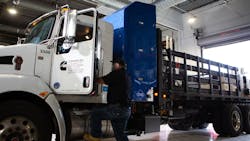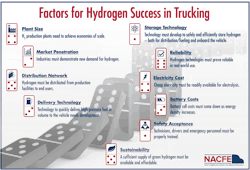Of course, there are questions when looking to adopt a new technology, and it is no different when it comes to hydrogen fuel cell electric vehicles (FCEVs). How do I fuel the vehicle? Where are the fueling stations? Do I need to buy both the vehicle and a fueling station?
The hub-and spoke duty cycle, where trucks return to base each day, is gaining in viability for FCEVs, noted Wido Westbroek, senior director of fuel cell strategic projects for Cummins, “and so, you’re not looking at the long-distance haulers where they need to have fueling along the road.”
In this scenario, an FCEV with a range of 500 miles would not need to rely on a public hydrogen fueling infrastructure station, but rather would fuel up at home base. A fleet would need several FCEVs to justify installing their own fueling infrastructure, though, Westbroek added.
See also: The dawn of hydrogen trucks
And installing those hydrogen fueling stations at scale will remain a major hurdle. According to the latest Department of Energy data, California currently has seven heavy-duty fueling stations, with two more planned. The light-duty space has far more options, with 54 open and 34 planned.
“The other big barrier, of course, is cost,” said Westbroek of what is preventing more heavy-duty hydrogen infrastructure. “Whenever anything starts, the first few, the first 100, even the first 1,000 are way more expensive than when you have tens of thousands, or hundreds of thousands.”
“The costs of hydrogen, vehicles, and hydrogen production all must come down significantly to make hydrogen economically competitive with alternatives,” noted Mike Roeth, executive director of the North American Council for Freight Efficiency, which released a detailed confidence report on the viability of FCEVs. After speaking with industry experts and researchers, Roeth surmised that “these costs will be reduced through scale and innovation over time.”What makes the uphill climb even more steep is that diesel, already proven and with bountiful infrastructure, provides a cost advantage for fleets, which operate on slim margins as it is.
“There has to be funding available, enough interest, enough support, whether it’s within the company itself, or whether they’re getting outside support from government agencies, to lower that hurdle to get those first trucks out on the road,” Westbroek said.
It is only once the fueling infrastructure and the cost come together that mass adoption will take place and FCEVs can be on the road at scale.
“There is a real recognition that this is no longer a hype cycle that we’re in,” Westbroek proclaimed. “There is now a real urgent need, a strong sense of what we call ‘winds at our back,’ whether it be government agencies talking it up, whether it’s politicians that are seeing the need to adopt and move this forward—everyone is starting to see that we are not talking about the next one, or two, or three years; we are seeing it over the next three to 10 years that this is an ever-rising curve.
“The urgency is not just to continue to move the cost down to lower that barrier, but also there is urgency to lay the foundation of knowledge within the operations people, the maintenance people, all those other skill sets that have to participate in ensuring that it is a success when it’s on the road. That is also now part of our work,” he reinforced. “And there is a lot of work that needs to be done to help people understand how to maintain, how to support the vehicle once it is on the road… Success doesn’t end with the delivery of the truck. It is it really that full lifecycle.”
And though it may seem as if the industry is at the tip of the diving board, it may be time to take the plunge into the next zero-emission solution.
Hydrogen FCEV manufacturers and current deployment plans
Symbio
Symbio H2 Central Valley Express—Q3 of 2023, a Class 8 FCEV will run a 12-month cycle on a 400-mile route in Southern California
Cummins
Class 8 conversions to FCEVs in Southern California
Nikola
Pilot testing of Alpha Tre FCEV with Anheuser-Bush, TTSI, and others in Southern California
Beta Tre FCEV development in Q2 2022 with pilot testing of Beta Tre FCEV in 2022 and 2023
Tre FCEV series production scheduled to start in the second half of 2023
Hyzon
Delivering 18 Hyzon FCEVs to Hylane in late 2022
cellcentric
Conceptualizing plans for large-scale series production in 2025
Hino
Prototype Class 8 XL8 FCEVs demonstrating drayage operations in a joint study through March 2026 in California ports
Hyundai
NorCAL ZERO project—Deploying 30 Class 8 XCIENT Fuel Cell trucks to northern California beginning in Q2 2023
Demonstrating two Class 8 XCIENT Fuel Cell trucks in Southern California as part of an EPA-funded project in the South Coast Air Basin.
Kenworth Trucks
Piloted a Kenworth T680 FCEV in the Port of Los Angeles-led Shore-to-Store project
Paccar
Received about $33 million from the SuperTruck 3 program to develop and demonstrate 18 Class 8 FCEVs and BEVs, along with advanced batteries and a megawatt charging station
About the Author
Tyler Fussner
Associate Editor | Fleet Maintenance
Tyler Fussner is Managing Editor - Community Manager at Supply Chain Connect, part of the Design & Engineering Group at Endeavor Business Media.
Previously, Fussner served as the Associate Editor for Fleet Maintenance magazine. As part of Endeavor's Commercial Vehicle Group, his work has been published in FleetOwner magazine, as well as Bulk Transporter, Refrigerated Transporter, and Trailer-Body Builders.
Fussner's May 2022 print feature 'The dawn of hydrogen trucks' was named the best single technology article in B2B by the judges of the 2022 Folio: Eddie and Ozzie Awards. Fussner was also awarded Silver in the Technical Article category for the Trade Association Business Publications International (TABPI) 2021 Tabbie Awards.
Fussner previously served as Assistant Editor for Endeavor's Transportation Group on the PTEN, Professional Distributor, and VehicleServicePros.com brands.
Fussner studied professional writing and publishing at the University of Wisconsin-Whitewater. He has experience in shop operations, is a Michelin Certified Tire Technician, and a Michelin Certified Tire Salesperson.


